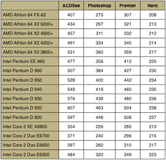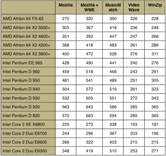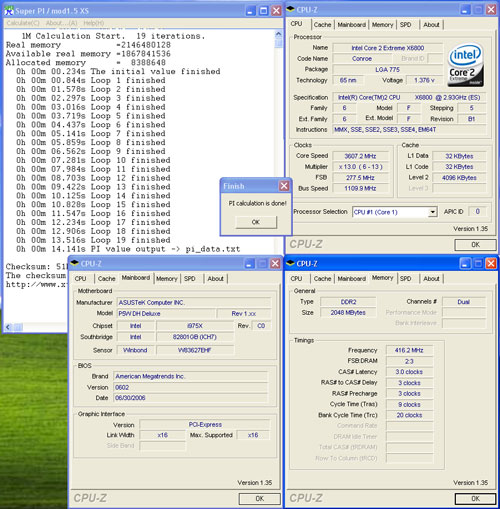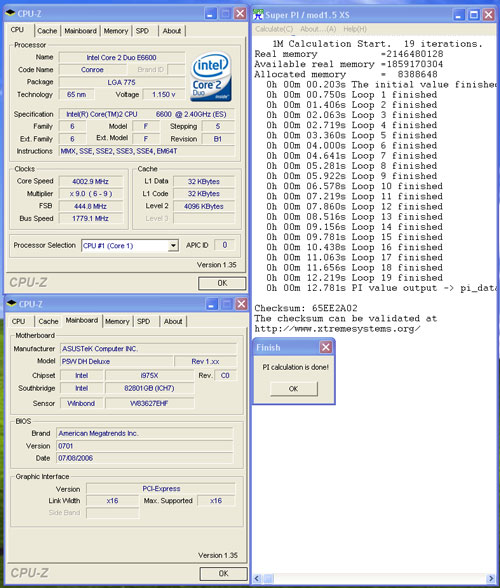
Original Link: https://www.anandtech.com/show/2045
Intel's Core 2 Extreme & Core 2 Duo: The Empire Strikes Back
by Anand Lal Shimpi on July 14, 2006 12:00 AM EST- Posted in
- CPUs
The architecture is called Core, processor family is Core 2, the product names are Core 2 Duo and Core 2 Extreme. In the past we've talked about its architecture and even previewed its performance, but today is the real deal. We've all been waiting for this day, the day Intel lifts the last remaining curtain on the chip that is designed to re-take the performance crown from AMD, to return Intel to its days of glory.
It sure looks innocent enough:

Core 2 Duo (left) vs. Pentium D (right)
What you see above appears to be no different than a Pentium D. Honestly, unless you flip it over there's no indication of what lies beneath that dull aluminum heat spreader.

Core 2 Duo (left) vs. Pentium D (right)
But make no mistake, what you see before you is not the power hungry, poor performing, non-competitive garbage (sorry guys, it's the truth) that Intel has been shoving down our throats for the greater part of the past 5 years. No, you're instead looking at the most impressive piece of silicon the world has ever seen - and the fastest desktop processor we've ever tested. What you're looking at is Conroe and today is its birthday.
Intel's Core 2 launch lineup is fairly well rounded as you can see from the table below:
| CPU | Clock Speed | L2 Cache |
| Intel Core 2 Extreme X6800 | 2.93GHz | 4MB |
| Intel Core 2 Duo E6700 | 2.66GHz | 4MB |
| Intel Core 2 Duo E6600 | 2.40GHz | 4MB |
| Intel Core 2 Duo E6400 | 2.13GHz | 2MB |
| Intel Core 2 Duo E6300 | 1.86GHz | 2MB |
As the name implies, all Core 2 Duo CPUs are dual core as is the Core 2 Extreme. Hyper Threading is not supported on any Core 2 CPU currently on Intel's roadmaps, although a similar feature may eventually make its debut in later CPUs. All of the CPUs launching today also support Intel's Virtualization Technology (VT), run on a 1066MHz FSB and are built using 65nm transistors.
The table above features all of the Core 2 processors Intel will be releasing this year. In early next year Intel will also introduce the E4200, which will be a 1.60GHz part with only a 800MHz FSB, a 2MB cache and no VT support. The E4200 will remain a dual core part, as single core Core 2 processors won't debut until late next year. On the opposite end of the spectrum Intel will also introduce Kentsfield in Q1 next year, which will be a Core 2 Extreme branded quad core CPU from Intel.
Core 2 Extreme vs. Core 2 Duo
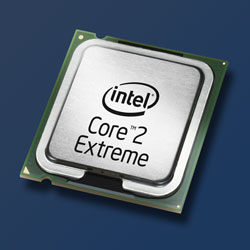 Previously Intel had differentiated its "Extreme" line of processors by giving them larger caches, a faster FSB, Hyper Threading support, and/or higher clock speeds. With the Core 2 processor family, the Extreme version gets a higher clock speed (2.93GHz vs. 2.66GHz) and this time around it also gets an unlocked multiplier. Intel officially describes this feature as the following:
Previously Intel had differentiated its "Extreme" line of processors by giving them larger caches, a faster FSB, Hyper Threading support, and/or higher clock speeds. With the Core 2 processor family, the Extreme version gets a higher clock speed (2.93GHz vs. 2.66GHz) and this time around it also gets an unlocked multiplier. Intel officially describes this feature as the following:
Core 2 Extreme is not truly "unlocked". Officially (per the BIOS Writers Guide), it is "a frequency limited processor with additional support for ratio overrides higher than the maximum Intel-tested bus-to-core ratio." Currently, that max tested ratio is 11:1 (aka 2.93G @ 1066 FSB). The min ratio is 6:1. However, do note that the Core 2 Extreme will boot at 2.93G unlike prior generation XE processors which booted to the lowest possible ratio and had to be "cranked up" to the performance ratio.
In other words, you can adjust the clock multiplier higher or lower than 11.0x, which hasn't been possible on a retail Intel chip for several years. By shipping the Core 2 Extreme unlocked, Intel has taken yet another page from AMD's Guide to Processor Success. Unfortunately for AMD, this wasn't the only page Intel took.
Manufacturing Comparison
The new Core 2 processors, regardless of L2 cache size, are made up of 291 million transistors on a 143 mm^2 die. This makes the new chips smaller and cheaper to make than Intel's Pentium D 900 series. The new Core 2 processors are also much smaller than the Athlon 64 X2s despite packing more transistors thanks to being built on a 65nm process vs. 90nm for the X2s.
| CPU | Manufacturing Process | Transistor Count | Die Size |
| AMD Athlon 64 X2 (2x512KB) | 90nm | 154M | 183 mm^2 |
| Intel Core 2 | 65nm | 291M | 143 mm^2 |
| Intel Pentium D 900 | 65nm | 376M | 162 mm^2 |
Intel's smaller die and greater number of manufacturing facilities results in greater flexibility with pricing than AMD.
New Pricing
As you will soon see, Intel's new Core 2 lineup has basically made all previous Intel processors worthless. The performance of the new Core 2 CPUs is so much greater, with much lower power consumption, that owners of NetBurst based processors may want to dust off the old drill bits and make some neat looking keychains.
Intel also realizes that its new Core 2 line will make its older Pentium D and Pentium Extreme Edition processors seem a bit homely, and thus it will significantly reduce the pricing on some of the CPUs by the end of this month to help spruce them up a bit.
Intel's new pricing, effective starting July 23rd, is listed below:
| CPU | Clock Speed | L2 Cache | Price |
| Intel Core 2 Extreme X6800 | 2.93GHz | 4MB | $999 |
| Intel Core 2 Duo E6700 | 2.66GHz | 4MB | $530 |
| Intel Core 2 Duo E6600 | 2.40GHz | 4MB | $316 |
| Intel Core 2 Duo E6400 | 2.13GHz | 2MB | $224 |
| Intel Core 2 Duo E6300 | 1.86GHz | 2MB | $183 |
| Intel Pentium D 945 | 3.40GHz | 2MBx2 | $163 |
| Intel Pentium D 915 | 2.80GHz | 2MBx2 | $133 |
| Intel Pentium D 820 | 2.80GHz | 1MBx2 | $113 |
| Intel Pentium D 805 | 2.66GHz | 1MBx2 | $93 |
The table above only showcases the NetBurst CPUs that are actually cheaper than their Core 2 counterparts; there are a number that are priced equal to Core 2 options, but you'll want to stay away from those (more blatant foreshadowing).
Unfortunately AMD won't have an architectural update of the Athlon 64 X2 until sometime in 2007 or 2008, thus its only response to Intel's Core 2 lineup today is to also reduce pricing. Shortly before today's launch AMD informed us that more aggressive price cuts for the Athlon 64 X2 line were coming in July, but we couldn't get any more specific information. The best numbers we've got are those that were leaked shortly after Computex, which may end up being higher than what AMD is now thinking of doing:
| CPU | Clock Speed | L2 Cache | Projected Price |
| AMD Athlon 64 X2 5000+ | 2.6GHz | 512KBx2 | $403 |
| AMD Athlon 64 X2 4600+ | 2.4GHz | 512KBx2 | $301 |
| AMD Athlon 64 X2 4200+ | 2.2GHz | 512KBx2 | $240 |
| AMD Athlon 64 X2 3800+ | 2.0GHz | 512KBx2 | $169 |
In order to keep prices competitive, AMD is also killing off its Athlon 64 X2s with a 1MB L2 cache. By only shipping 512KB parts (except for the limited quantities of FX processors that are sold), AMD can produce more CPUs per wafer and thus help increase supply and offer lower prices.
Below we've compared both AMD and Intel's proposed price cuts, and as you can see, AMD needs to do a lot more in order to remain competitive.
| CPU | Clock Speed | L2 Cache | Price |
| Intel Core 2 Extreme X6800 | 2.93GHz | 4MB | $999 |
| Intel Core 2 Duo E6700 | 2.66GHz | 4MB | $530 |
| AMD Athlon 64 X2 5000+ | 2.6GHz | 512KBx2 | $403* |
| Intel Core 2 Duo E6600 | 2.40GHz | 4MB | $316 |
| AMD Athlon 64 X2 4600+ | 2.4GHz | 512KBx2 | $301* |
| AMD Athlon 64 X2 4200+ | 2.2GHz | 512KBx2 | $240* |
| Intel Core 2 Duo E6400 | 2.13GHz | 2MB | $224 |
| Intel Core 2 Duo E6300 | 1.86GHz | 2MB | $183 |
| AMD Athlon 64 X2 3800+ | 2.0GHz | 512KBx2 | $169* |
| Intel Pentium D 945 | 3.40GHz | 2MBx2 | $163 |
| Intel Pentium D 915 | 2.80GHz | 2MBx2 | $133 |
| Intel Pentium D 820 | 2.80GHz | 1MBx2 | $113 |
| Intel Pentium D 805 | 2.66GHz | 1MBx2 | $93 |
*Note: The AMD prices are still rumored. We're waiting for final confirmation from AMD for accuracy.
Based on these prices, AMD's Athlon 64 X2 4600+ would have to beat Intel's E6600, the 4200+ would have to beat the E6400 and the X2 3800+ would have to be somewhere in between the performance of a Pentium D 940/945 and an E6300.
We're getting the impression that AMD may be cutting prices more than what we've seen here, but we have no idea to what degree yet. By the end of this year AMD will also offer higher clock speeds as well as its new 4x4 platform (dual socket, dual core desktop Athlon 64 FX motherboards), but that's all we can expect for the foreseeable future.
The Test
We've already covered the architecture behind Intel's Core 2 processors extensively in the past, leaving the only unanswered questions centered around final performance. Today we're here to answer these questions, and we'll focus exclusively on performance. If you want to read more about Intel's Core architecture, please look back at the following articles:
Because AMD is killing off its 1MB L2 Athlon 64 X2 parts, we've only included 512KB X2s in this review. The Athlon 64 FX-62 features a 1MB L2 per core and is obviously still included.
| CPU: | AMD Athlon 64 FX-62 (2.8GHz/1MBx2) AMD Athlon 64 X2 5000+ (2.6GHz/512KBx2) AMD Athlon 64 X2 4600+ (2.4GHz/512KBx2) AMD Athlon 64 X2 4200+ (2.2GHz/512KBx2) AMD Athlon 64 X2 3800+ (2.0GHz/512KBx2) Intel Pentium Extreme Edition 965 (3.73GHz/2MBx2) Intel Pentium D 960 (3.6GHz/2MBx2) Intel Pentium D 950 (3.4GHz/2MBx2) Intel Pentium D 940 (3.2GHz/2MBx2) Intel Pentium D 930 (3.0GHz/2MBx2) Intel Pentium D 920 (2.8GHz/2MBx2) Intel Pentium D 820 (2.8GHz/1MBx2) Intel Core 2 Extreme X6800 (2.93GHz/4MB) Intel Core 2 Duo E6700 (2.66GHz/4MB) Intel Core 2 Duo E6600 (2.40GHz/4MB) Intel Core 2 Duo E6300 (1.86GHz/2MB) |
| Motherboard: | MSI K9A Platinum (Socket AM2) Intel D975XBX (LGA-775) |
| Chipset: | ATI RD580 Intel 975X |
| Chipset Drivers: | Catalyst 6.6 (ATI) Intel 7.2.2.1007 (Intel) |
| Hard Disk: | Seagate 7200.9 300GB SATA |
| Memory: | Corsair XMS2 DDR2-800 4-4-4-12 (1GB x 2) |
| Video Card: | 2 x ATI Radeon X1900 XT CrossFire |
| Video Drivers: | ATI Catalyst 6.6 |
| Desktop Resolution: | 1280 x 1024 - 32-bit @ 60Hz (1600 x 1200 for games) |
| OS: | Windows XP Professional SP2 |
L2 Cache: 4MB or 2MB?
The majority of Intel's Core 2 Duo line feature a single shared 4MB L2 cache, but the E6300 and E6400 are only equipped with a 2MB cache. Given that the Core 2 Duo doesn't have an on-die memory controller, it is more dependent on larger caches than AMD's Athlon 64 X2, which raises the question - how big of a difference is there between the 2MB L2 and 4MB L2 parts?
Our Core 2 Extreme X6800 (2.93GHz) part, like all X6800s, is unlocked so we could simulate any other Core 2 Duo clock speed with it. We managed to get our hands on a Core 2 Duo E6300 (1.86GHz/2MB) and we were in business.
The graph below features all of the benchmarks we ran on the processors in this review, showing the percent performance improvement from a Core 2 Duo E6300 (1.86GHz/2MB) to a hypothetical 1.86GHz Core 2 Duo with a 4MB L2 cache. The bar labeled "Average" is simply an average of all of the performance improvements graphed on the chart.
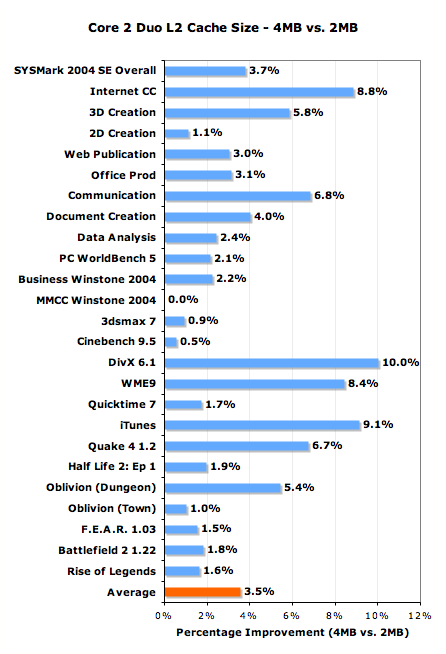
The 4MB L2 cache can increase performance by as much as 10% in some situations. Such a performance improvement is definitely tangible, and as applications grow larger in their working data sets then the advantage of a larger cache will only become more visible. Unfortunately, you do pay a price premium for this added performance and future proofing as the cheapest 4MB L2 part is the E6600 priced at $316.
If you're the type to upgrade often, then the extra cache is not worth it as you're not getting enough of a present day increase in performance to justify the added cost. However, if this processor will be the basis for your system for the next several years, we'd strongly recommend picking a 4MB flavor of Core 2.
Memory Latency: No Integrated Memory Controller Necessary
One thing we pointed out in our earlier preview coverage of Intel's Core 2 Extreme is that the new processors have extremely low latency memory access, despite relying on the same memory controller as the previous generation of Intel CPUs.
Without an on-die memory controller Intel's Core 2 processor must use the memory controller in its chipset, which currently means the 128-bit DDR2 memory controller in either Intel's 965 or 975X chipset. The confusing thing is that although the Core 2 processors use the same memory controller as the old NetBurst processors, memory latency has been improved tremendously:
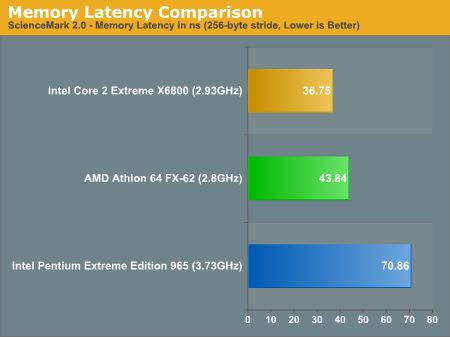
Intel's Core 2 processors now offer even quicker memory access than AMD's Athlon 64 X2, without resorting to an on-die memory controller. While Intel will eventually add one, the fact of the matter is that it's simply not necessary for competitive memory performance today thanks to Intel's revamped architecture. Update:As many astute readers have pointed out, Core 2's prefetchers are able to work their magic with ScienceMark 2.0, which results in the significant memory latency advantage over AMD's Athlon 64 FX-62. This advantage will not always exist; where it doesn't, AMD will continue to have lower latency memory access and where it does, Intel can gain performance advantages similar to what ScienceMark 2.0 shows.
| CPU | Everest |
CPU-Z 1.35 (8192KB, 128-byte stride) | CPU-Z 1.35 (8192KB, 64-byte stride) |
| AMD Athlon 64 FX-62 (2.8GHz) | 45.9 ns | 43.2 ns | 19.3 ns |
| Intel Core 2 Extreme X6800 (2.93GHz) | 59.8 ns | 52.8 ns | 10.9 ns |
Because of the Core 2's intelligent prefetchers doing too good of a job with ScienceMark memory latency test, we wanted to also showcase situations where Core 2 would feature slower memory accesses than the AMD platform with its integrated memory controller. Everest's results are more in line with what we'd expect to see, with the FX-62 offering over 23% faster memory accesses than the X6800. CPU-Z's latency tool also reported somewhat similar findings, with an 18% performance advantage due to AMD's integrated memory controller. CPU-Z also provided us with numbers that showcase how well Core 2 can perform if its prefetchers are able to "guess" correctly; at lower strides the Core 2 Extreme manages faster memory access than the FX-62. The 128-byte stride numbers are indicative of what will happen if the pre-fetchers are not able to get the Core 2 the data it needs, when it needs it, while the 64-byte numbers show you what can happen when things go well.
FSB Bottlenecks: Is 1333MHz Necessary?
Although all desktop Core 2 processors currently feature a 1066MHz FSB, Intel's first Woodcrest processors (the server version of Conroe) offer 1333MHz FSB support. Intel doesn't currently have a desktop chipset with support for the 1333MHz FSB, but the question we wanted answered was whether or not the faster FSB made a difference.
We took our unlocked Core 2 Extreme X6800 and ran it at 2.66GHz using two different settings: 266MHz x 10 and 333MHz x 8; the former corresponds to a 1066MHz FSB and is the same setting that the E6700 runs at, while the latter uses a 1333MHz FSB. The 1333MHz setting used a slightly faster memory bus (DDR2-811 vs. DDR2-800) but given that the processor is not memory bandwidth limited even at DDR2-667 the difference between memory speeds is negligible.
With Intel pulling in the embargo date of all Core 2 benchmarks we had to cut our investigation a bit short, so we're not able to bring you the full suite of benchmarks here to investigate the impact of FSB frequency. That being said, we chose those that would be most representative of the rest.
Why does this 1333MHz vs. 1066MHz debate even matter? For starters, Core 2 Extreme owners will have the option of choosing since they can always just drop their multiplier and run at a higher FSB without overclocking their CPUs (if they so desire). There's also rumor that Apple's first Core 2 based desktops may end up using Woodcrest and not Conroe, which would mean that the 1333MHz FSB would see the light of day on some desktops sooner rather than later.
The final reason this comparison matters is because in reality, Intel's Core architecture is more data hungry than any previous Intel desktop architecture and thus should, in theory, be dependent on a nice and fast FSB. At the same time, thanks to a well engineered shared L2 cache, FSB traffic has been reduced on Core 2 processors. So which wins the battle: the data hungry 4-issue core or the efficient shared L2 cache? Let's find out.
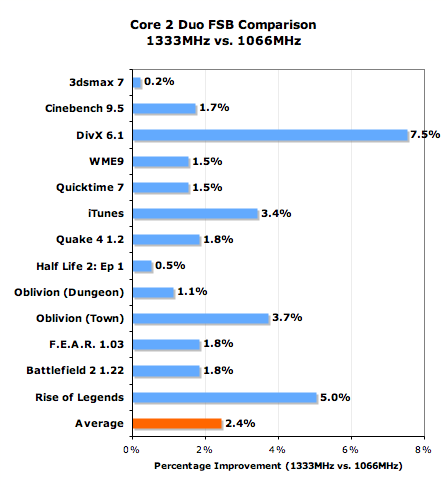
On average at 2.66GHz, the 1333MHz FSB increases performance by 2.4%, but some applications can see an even larger increase in performance. Under DivX, the performance boost was almost as high as going from a 2MB L2 to a 4MB L2. Also remember that as clock speed goes up, the dependence on a faster FSB will also go up.
Thanks to the shared L2 cache, core to core traffic is no longer benefitted by a faster FSB so the improvements we're seeing here are simply due to how data hungry the new architecture is. With its wider front end and more aggressive pre-fetchers, it's no surprise that the Core 2 processors benefit from the 1333MHz FSB. The benefit will increase even more as the first quad core desktop CPUs are introduced. The only question that remains is how long before we see CPUs and motherboards with official 1333MHz FSB support?
If Apple does indeed use a 1333MHz Woodcrest for its new line of Intel based Macs, running Windows it may be the first time that an Apple system will be faster out of the box than an equivalently configured, non-overclocked PC. There's an interesting marketing angle.
Power Consumption: Who is the king?
Intel promised us better performance per watt, lower energy consumed per instruction, and an overall serious reduction in power consumption with Conroe and its Core 2 line of processors. Compared to its NetBurst predecessors, the Core 2 lineup consumes significantly lower power - but what about compared to AMD?
This is one area that AMD is not standing still in, and just days before Intel's launch AMD managed to get us a couple of its long awaited Energy Efficient Athlon 64 X2 processors that are manufactured to target much lower TDPs than its other X2 processors. AMD sent us its Athlon 64 X2 4600+ Energy Efficient processor which carries a 65W TDP compared to 89W for the regular 4600+. The more interesting CPU is its Athlon 64 X2 3800+ Energy Efficient Small Form Factor CPU, which features an extremely low 35W rating. We've also included the 89W Athlon 64 X2s in this comparison, as well as the 125W Athlon 64 FX-62.
Cool 'n Quiet and EIST were enabled for AMD and Intel platforms respectively; power consumption was measured at the wall outlet. We used an ASUS M2NPV-VM for our AM2 platform and ASUS' P5W DH Deluxe for our Core 2 platform, but remember that power consumption will be higher with a SLI chipset on either platform. We used a single GeForce 7900 GTX, but since our power consumption tests were all done at the Windows desktop 3D performance/power consumption never came into play.
We took two power measurements: peak at idle and peak under load while performing our Windows Media Encoder 9 test.
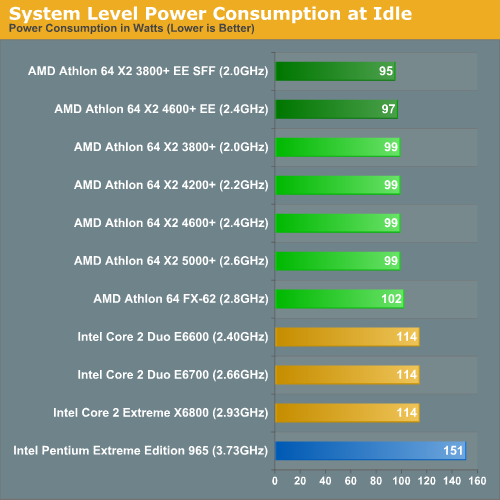
Taking into consideration the fact that we were unable to compare two more similar chipsets (we will take a look back at that once retail Intel nForce 5 products hit the shelves), these power numbers heavily favor Intel. The releative power savings over the Extreme Edition 965 show just how big the jump is, and the ~15% idle power advantage our lower power AMD motherboard has over the Intel solution isn't a huge issue, especially when considering the performance advantage for the realtively small power investment.
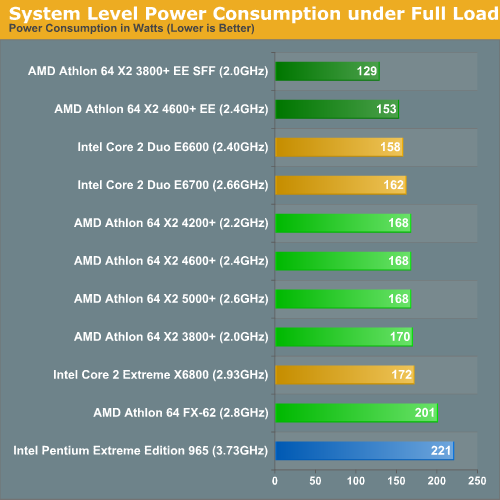
When looking at load power, we can very clearly see that AMD is no longer the performance per watt king. While the Energy Efficient (EE) line of X2 processors is clearly very good at dropping load power (especially in the case of the 3800+), not even these chips can compete with the efficiency of the Core 2 line while encoding with WME9. The bottom line is that Intel just gets it done faster while pulling fewer watts (e.g. Performance/Watt on the X6800 is 0.3575 vs. 0.2757 on the X2 3800+ EE SFF).
In fact, in a complete turn around from what we've seen in the past, the highest end Core 2 processor is actually the most efficient (performance per Watt) processor in the lineup for WME9. This time, those who take the plunge on a high priced processor will not be stuck with brute force and a huge electric bill.
Application Performance using SYSMark 2004 SE
We'll kick off our look at general application performance with SYSMark 2004 SE and as always, and we'll look at the overall score as well as the scores in each of the two suites - Internet Content Creation and Office productivity.
As we saw in our last preview of Intel's Core 2 Extreme processor, it posted SYSMark scores that were well beyond anything either AMD or Intel had been able to deliver in the past. With the final version of Core 2 silicon in our hands and a more stable/tweaked platform, we got even better numbers out of Conroe:
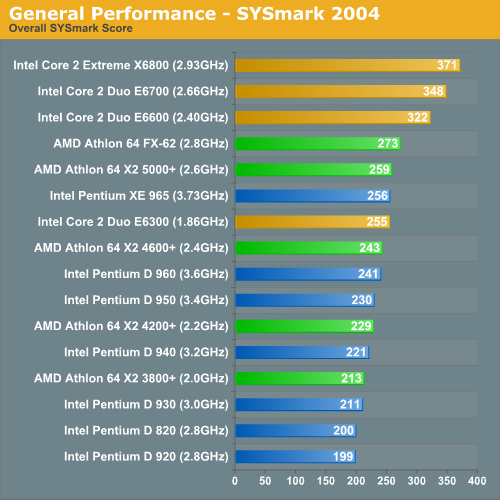
At the high end, the Core 2 Extreme X6800 was just under 36% faster than the Athlon 64 FX-62. In fact, even the $316 E6600 was around 18% faster than AMD's fastest. To add even more insult to injury the slowest Core 2 Duo in the test, the 1.86GHz E6300 is barely slower than AMD's fastest Athlon 64 X2.
The old Intel lineup of Pentium D processors is truly an embarrassment. Only the Extreme Edition 965 is remotely competitive and even then it can barely outperform the $183 E6300.
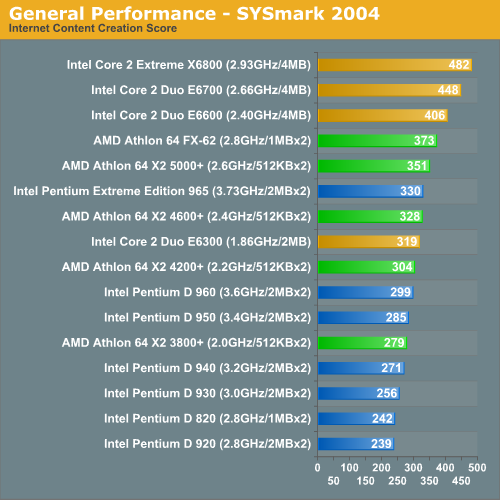
Drilling down into the SYSMark scores we've got the overall ICC results, which honestly are not much different than the overall scores we saw above. The Core 2 Extreme X6800 holds a 29% performance advantage over the FX-62 and once again, and the E6600 is able to outperform AMD's best by over 8%.
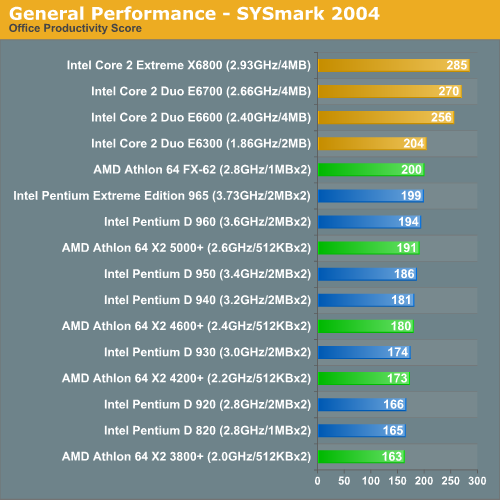
Intel's Core 2 performance domination continues in the Office Productivity portion of SYSMark 2004, with the Core 2 Extreme X6800 maintaining a 42.5% performance advantage over the FX-62. This time around, even the E6300 manages to remain competitive with the FX-62. This is Intel's new $183 part offering performance equal to that of AMD's $1,000 flagship FX processor; it's going to take a lot for AMD to recover from this deficit.
The individual SYSMark 2004 SE scores are graphed below if you're interested. The data is used in calculating the overall scores we've already discussed above:
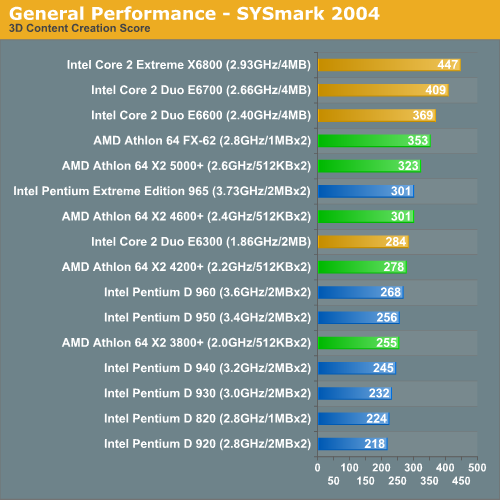
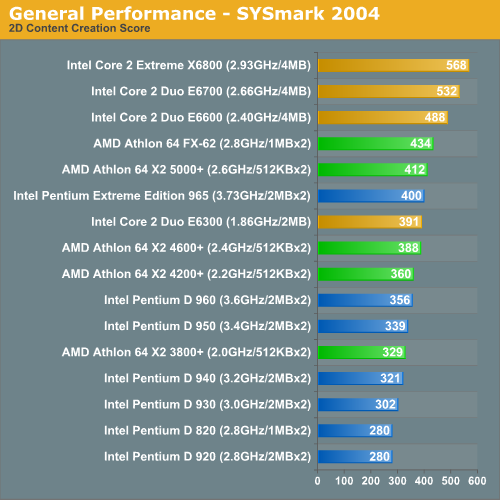
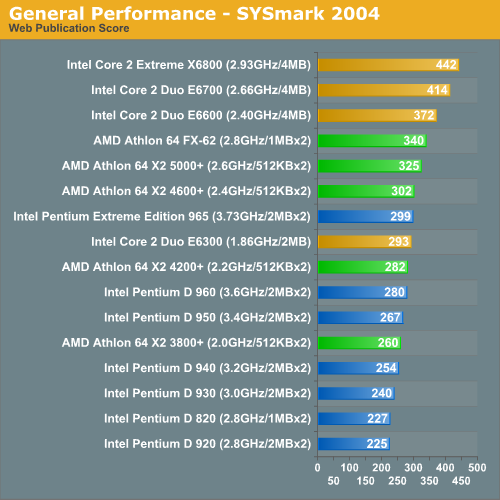
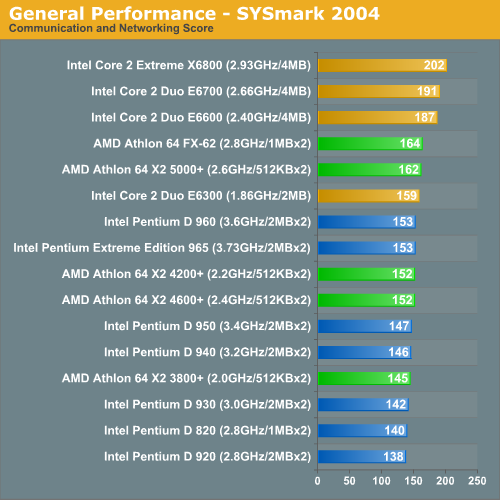
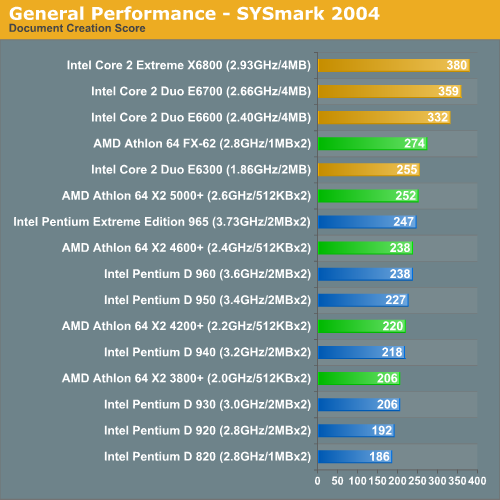
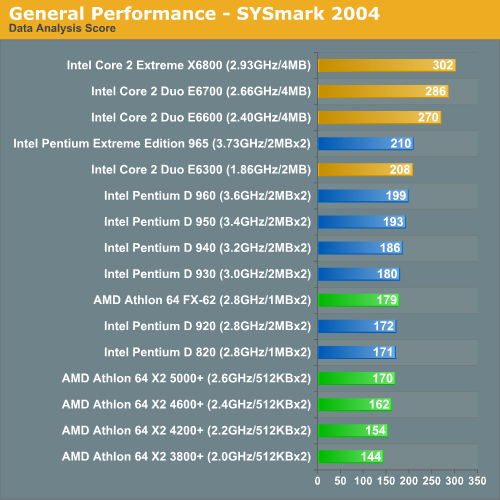
Application Performance using PC WorldBench 5
Looking at the overall WorldBench 5 performance score, Intel's Core platform has a lead of 15% at the high-end and 10% at the low-end.
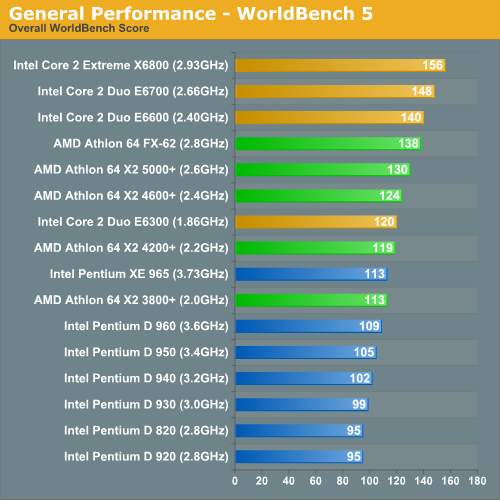
The midrange options show similar results. Of course, the overall performance score is something of an abstraction, so it's also important to look at the individual results. (Click on the images below for detailed results; the numbers are completion times in seconds - lower numbers are better).
Click Images to Enlarge |
||
Intel leads in almost every instance, with AMD's only win coming in the Ahead Nero Express test. That particular test is mostly I/O limited, however, so the win doesn't particularly count for much. The margins in Adobe Premier, Microsoft Office XP, and 3D Studio Max 5.1 are a bit closer (3%-11%), while the Photoshop, Mozilla, Windows Media Encoder, WinZip, and the multitasking test all favor the Core 2 Duo chips by a slightly larger margin (12%-26%). The net result is clearly a victory for Intel, however.
Application Performance using Winstone 2004
Winstone 2004 consists of two different benchmark suites; the Business Winstone test focuses on office applications, while the Multimedia Content Creation benchmark contains many audio/visual applications that are more CPU limited. Realistically, we wouldn't put too much stock in the Business Winstone test, as the majority of applications will spend their time waiting on the user.
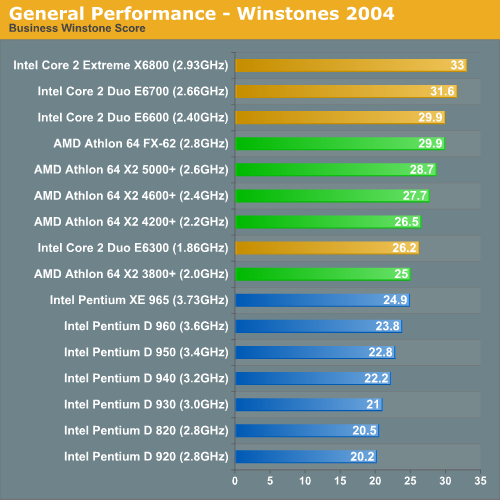

Looking at the results, the Core 2 Extreme comes out ahead of the FX-62 by 9% and 10% in the Business and MCC tests, respectively. The Core 2 Duo E6300 on the other hand takes a 5% lead over the X2 3800+ in the business test, and basically ties with it in the MCC results. For the price/performance segment, the result is basically a tie, while the Core 2 Extreme continues to maintain a 10% or higher lead in the maximum performance arena.
3D Rendering Performance using 3dsmax 7 & CineBench 9.5
We're looking at 3D rendering performance using two different applications: 3D Studio Max and Cinebench 9.5. Cinebench is a free performance testing utility based off of the CINEMA 4D R8 rendering package. Our scores from 3D Studio Max are a composite score from four rendering tests: CBalls2, SinglePipe2, UnderWater, and 3dsmax5 Rays.
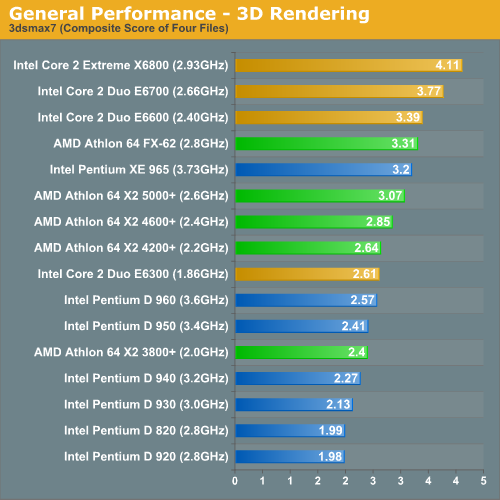
The Core 2 Extreme leads by 24% in the 3D Studio Max composite score, with performance leads in the individual tests ranging from 20% to 31%. At the lower end of the performance spectrum, the E6300 averages a 9% lead over the X2 3800+ and performs about equal to the 4200+. The margin of victory over the 3800+ ranges from 7% to 12% in the individual results.
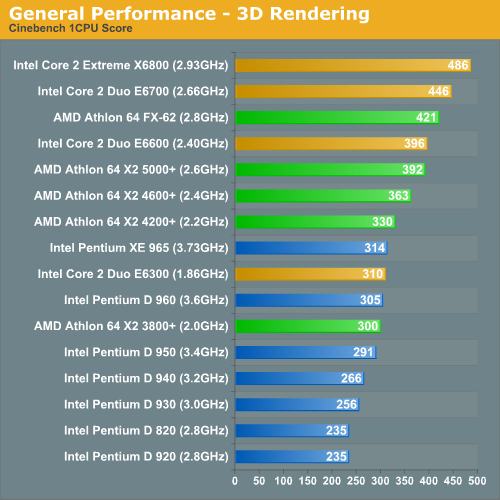

Moving on to Cinebench, Core 2 Extreme takes the performance crown again, but with a closer margin of victory than in 3dsmax: 14%-15% in SMP and single CPU modes. The Core 2 Duo E6300 barely comes out ahead of the X2 3800+, but the 1%-3% lead is basically a tie.
Encoding Performance using DivX 6.1, WME9, Quicktime (H.264) & iTunes
Multimedia encoding is typically a very good CPU benchmark, with performance that scales very nearly linearly with faster CPU clock speeds. Video testing was conducted using three popular codecs and applications: Xmpeg 5.03 with DivX 6.1, Windows Media Encoder with WMV9, and QuickTime 7.1 with H.264. The complexity of the encoding process increases as we move from DivX to WMV9, and H.264 encoding is in a league of its own in terms of the amount of CPU time required.
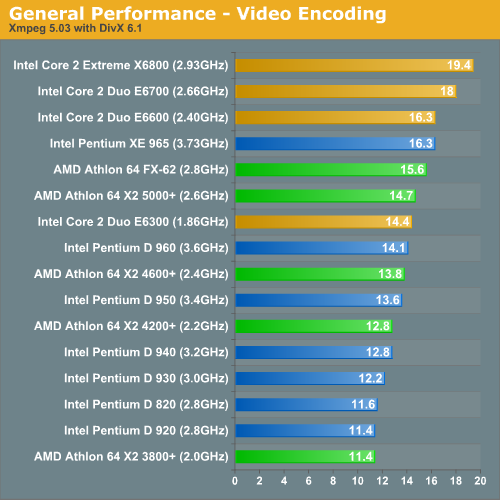
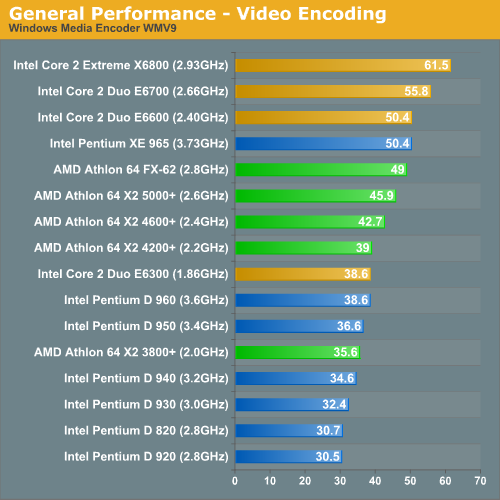
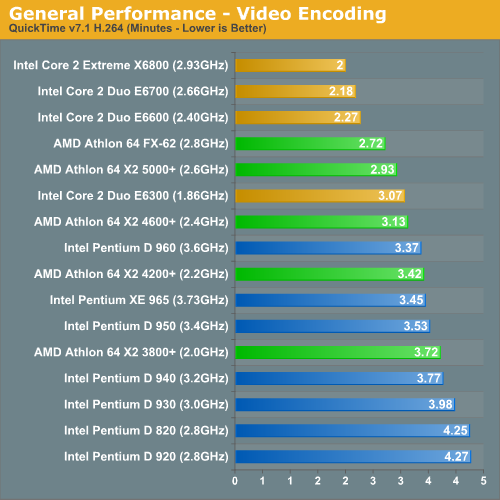
In something of a change, both the Core 2 Extreme and that E6300 manage roughly a 25% margin of victory over their AMD counterparts in the DivX test. The E6300 very nearly matches the X2 5000+ here. The X6800 maintains the 25% lead in WMV9, while the E6300 lead over the X2 3800+ drops to 8.5%, roughly equaling the 4200+. Finally, in H.264 encoding, the Core 2 Extreme claims one of its largest victories coming in 36% faster than the Athlon FX-62; the E6300 also manages a large 21% performance lead over the X2 3800+ and falls between the 4600+ and 5000+ in performance.
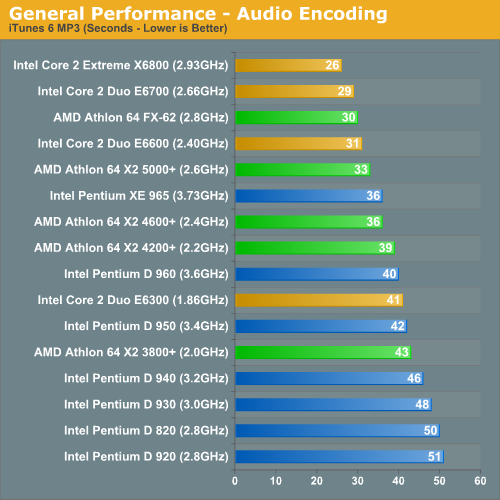
Moving over to audio encoding performance, we used Apple's iTunes 6 application to encode a single 307 MB Wav file into a 192kbps MP3. Audio encoding is still very CPU intensive, but of course the faster encoding times make the differences less noticeable in practical use. At the top and bottom price points, Intel leads again: 5% at the low-end, and 15% at the extreme performance segment. Unless you frequently encode really large amounts of audio files, however, it's unlikely you're going to notice Intel's 2-4 second lead.
Gaming with Core 2 and CrossFire on 975X
We were so used to getting excited over AMD processor launches that we almost forgot what an important Intel CPU launch was like. You see, AMD and Intel behave very differently when at a dinner table preparing to eat their meals. AMD will eat when its partners eat; companies like ATI and NVIDIA get to share in the joy of a new AMD product launch as they are busy building chipsets for the new platform. That's why we get a new nForce chipset whenever AMD launches a new CPU. Intel on the other hand isn't as generous; Intel likes to eat first, and then whatever remains after it's nice and full can be scraped off the table and given to its partners. This is why today's launch is taking place pretty much exclusively on Intel chipsets, with retail products based on ATI/NVIDIA chipsets shipping in the coming months.
Intel's table manners aren't as nice as AMD's largely because they don't have to be. Intel has a lot more fabs than AMD, however they aren't all pumping out 65nm Core 2 Duos on 300mm wafers; instead many of them are still using old 90nm or 130nm process technology. It's not exactly economically feasible to keep converting all of the fabs to the latest technology as soon as it's available, so Intel uses up excess capacity in its older fabs by producing chipsets. AMD does not have this luxury so it depends on companies like ATI, NVIDIA, SiS and VIA for the platform side of things, and thus is much nicer at the dinner table.
Eating habits aside, what this means for us is that our only real options to test Core 2 Duo are with Intel chipsets. NVIDIA's nForce 590 SLI reference board for Core 2 Duo is in our labs but its BIOS isn't finalized yet so NVIDIA is asking us to hold off on using it for a couple more weeks. At the same time, we're hearing that we shouldn't expect any retail motherboards using ATI chipsets for Core 2 Duo motherboards until September at the earliest, once again leaving us with Intel.
Don't get us wrong; Intel chipsets are far from a terrible option. In fact, Intel continues to make extremely trouble-free platforms. It's not stability or performance that we're concerned about, as Intel has got both of those down pat. The issue however is multi-GPU compatibility.
You see, NVIDIA is a lot like Intel in that it wants to eat first or maybe, if the right people are at the table, at the same time as its partners. The problem with two companies that have identical eating habits is that no one ends up eating, and thus we have no SLI support on Intel chipsets. NVIDIA views this as an upper hand because honestly it's the only tangible advantage anyone has ever held over an Intel chipset since the days when Intel and Rambus were inseparable. If you want the best multi-GPU solution on the market you buy NVIDIA graphics cards, but they won't run (together) on Intel chipsets so you've got to buy the NVIDIA chipset as well - sounds like NVIDIA is trying to eat some of Intel's dinner, and this doesn't make Intel very happy.
Luckily for Intel, there's this little agreement it has with NVIDIA's chief competitor - ATI. Among other things, it makes sure that Intel platforms (or platform in this case, since it only officially works on the 975X) can support CrossFire, ATI's multi-GPU technology. Unfortunately, CrossFire isn't nearly as polished as NVIDIA's SLI. Case in point would be benchmarking for this Core 2 Duo article, which used a pair of X1900 XTs running in CrossFire mode. During our testing, CrossFire decided to disable itself after a simple reboot - twice. No warnings, no hardware changes, just lower frame rates after a reboot and a CrossFire enable checkbox that had become unchecked. Needless to say it was annoying, but by now we already know that CrossFire needs work and ATI is on it.
More than anything this is simply a message to ATI and Intel: if CrossFire had been in better shape, the high end gaming enthusiast could have been satisfied today, but instead they will have to wait a little longer for the first nForce 500 motherboards with Core 2 support to arrive (or settle for a nForce 4 board with Core 2 support).
Why does multi-GPU even matter? Given how fast Intel's Core 2 processors are, we needed to pair them with a GPU setup that was well matched - in this case we went with a pair of X1900 XTs running in CrossFire mode. With a pair of X1900 XTs we could run at 1600 x 1200 for all of our gaming tests, achieving a good balance between CPU and GPU loads and adequately characterizing the gaming performance of Intel's Core 2 line.
Gaming Performance using Quake 4, Battlefield 2 & Half Life 2 Episode 1
Our gaming performance analysis starts out with Quake 4 running at 1600 x 1200 with High Quality visual settings. We used version 1.2 of Quake 4 and SMP was enabled:
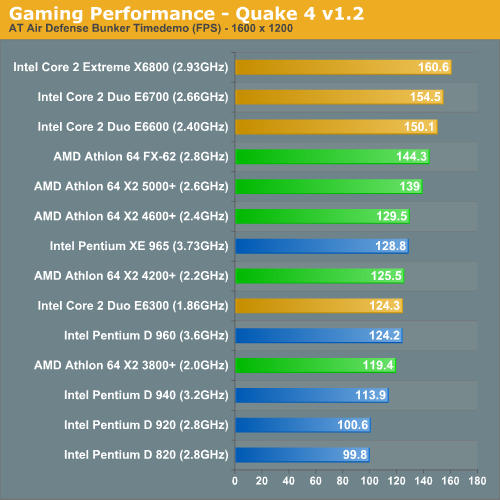
The performance advantage in Quake 4 starts off high, but not astronomical for the Core 2 processors. The Core 2 Extreme X6800 is just over 11% faster than the Athlon 64 FX-62, mainly because we're looking at it in a more GPU bound light than we have in the past. Regardless, it is a performance advantage and far better than the older days of NetBurst chips where Intel's best could barely keep up with AMD.
Looking at Battlefield 2 performance, Intel begins to improve its gaming performance lead as we are becoming more CPU bound:
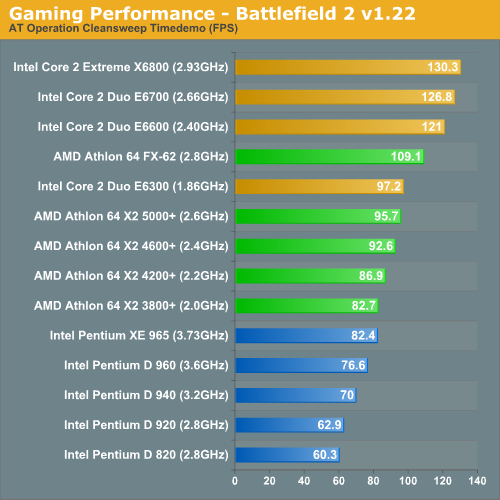
The Core 2 Extreme X6800 now attains a 19% performance lead over the FX-62, and the E6600 manages a 10.9% advantage itself.
Next up we've got the recently released Half Life 2: Episode 1, running at default quality settings (auto detected with a pair of X1900 XTs installed) with the exception of AA and aniso being disabled. As with all of our gaming tests in this article we tested at 1600 x 1200:
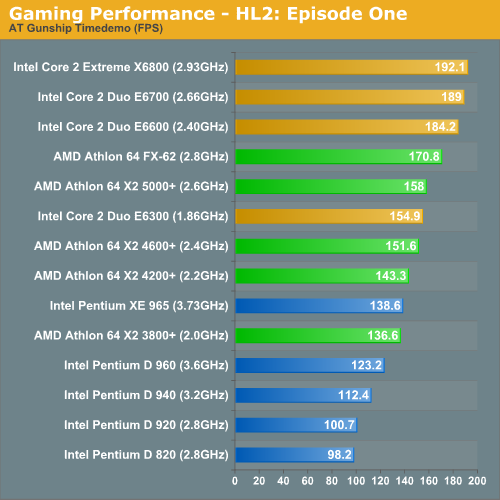
Half Life 2: Episode 1 provided us with numbers closer to what we saw with Quake 4, the performance advantage here is just over 12% for the X6800 over the FX-62. With a couple of speed bumps, AMD could equal Intel's gaming performance here. But the real issue for AMD is the fact that the E6600 priced at $316, is able to outperform the FX-62 at over twice the price. The E6300 continues to provide a great value but isn't nearly as impressive as the rest of the Core 2 line.
Gaming Performance using F.E.A.R. & Rise of Legends
Our F.E.A.R. test should be fairly familiar by now, as it is the built in performance test included with the game. Computer settings were left at "Maximum" while the graphics settings were set to "High" with the resolution cranked up to 1600 x 1200. F.E.A.R. ends up still being more GPU than CPU bound at these settings, even with a pair of X1900 XTs at its disposal, but we do see some separation among the processors:
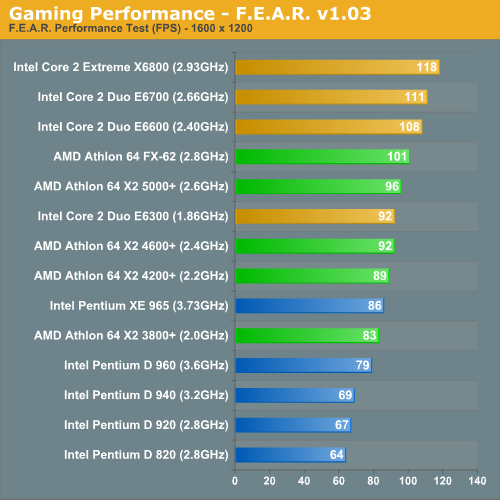
The top three spots still go to the top three Core 2 CPUs, with the E6300 falling around the level of the X2 4600+. A trend that we've been seeing all throughout this review is that the performance of these CPUs effectively falls into three groups: Core 2 processors at the top, Athlon 64 X2s in the middle and Pentium D at the very bottom of the charts. In a sense that's the easiest way to classify these three groups of processors: if you want the fastest it's Core 2, mid-range goes to the Athlon 64 X2 and if you don't like good performance there's always the Pentium D.
Rise of Legends is a newcomer to our game benchmark suite and what an excellent addition it is. This Real Time Strategy game looks very good and plays well too; it serves as good filler until the next Command & Conquer title eventually arrives for those looking for a RTS fix. We ran with the resolution set to 1600 x 1200 and the graphics settings set to the medium defaults. We recorded a custom playback of a 3 vs. 2 multiplayer battle and played it back at 4x speed, recording the average frame rate for 10 minutes of the battle. The 10 minutes we focused on contained a good mix of light skirmishes between opponents, base/resource management with very few characters on the screen and of course some very large scale battles.
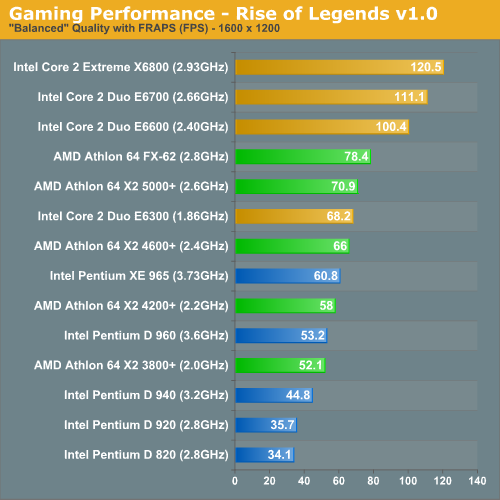
As with most RTSes, Rise of Legends is extremely CPU bound. The performance variability between runs was fairly high in this test, mainly because of how disk intensive the playback can get. Differences in performance of up to 5% should be ignored, but the standings are correct - the Core 2 line of processors absolutely demolish the competition: you're looking at true next-generation CPU performance here. The E6300 isn't nearly as impressive when compared to its more expensive siblings, but when you compare it to AMD's lineup it looks very good, especially considering its proposed cost.
Gaming Performance using Oblivion
Oblivion has never been kind to Intel's NetBurst processors, but it loves the new Core 2 processors:
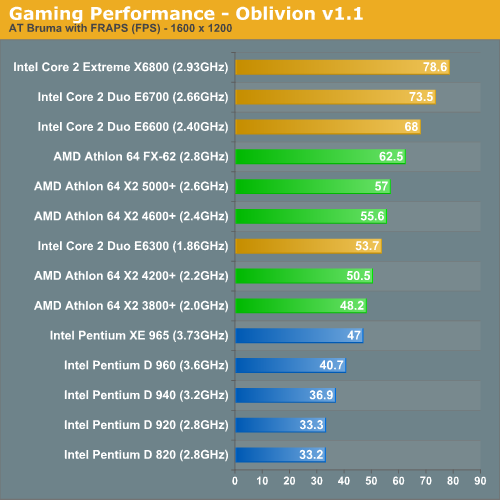
Our first test is the "Town" benchmark we used in our Oblivion performance guides. Here the Core 2 Extreme X6800 manages a 26% performance advantage over the FX-62. While the E6600 is still faster than the FX-62, the E6300 loses a few places and finds itself offering performance somewhere in between the X2 4600+ and the 4200+. Keep in mind that our Oblivion tests are hand run using FRAPS so the variance between runs is much higher than normal; differences of up to 5% should be ignored to be on the safe side.

In our "Dungeon" test, the Core 2 Extreme continues to dominate the charts, as do the E6700 and E6600. Once again we find the E6300 around the X2 4600+ in performance.
CPU Bound Gaming Performance
While we always try to run our gaming benchmarks in CPU reviews as a balance between being CPU and GPU bound, there is some merit to using CPU bound gaming scenarios as a true measure of the gaming power of a CPU.
The previous pages of gaming benchmarks were run at 1600 x 1200, which struck a good balance between being CPU and GPU bound on our CrossFire setup but here we’re looking at exactly how good of a gaming CPU the Core 2 Duo is. By running these tests at 640 x 480 with the same CrossFire setup as before we’re ensuring that the performance bottlenecks in these titles shift as far as possible from the GPU and onto the CPU.
These tests aren’t designed to tell you how fast these CPUs are at running these games, but rather how quickly they can run through the physics and AI code when not waiting on the graphics card at all.
We chose to look at two CPUs: the Core 2 Extreme X6800 and the Athlon 64 FX-62, to get an idea of how strong each architecture was at pure physics/AI processing in games. We also omitted any games whose performance didn’t change by dropping the resolution from 1600 x 1200 to 640 x 480 (meaning that those games were already predominantly CPU limited in our previous tests).
| CPU | Quake 4 | HL2 Ep 1 | F.E.A.R. | BF2 |
| AMD Athlon 64 FX-62 | 156.7 | 170.0 | 164.0 | 108.7 |
| Intel Core 2 Extreme X6800 | 192.5 | 263.5 | 236.0 | 142.3 |
| Advantage (Intel) | 22.8% | 55.0% | 43.9% | 30.9% |
In terms of sheer ability to process physics and AI as well as feed a hungry graphics subsystem, Intel's Core 2 Extreme X6800 is anywhere between 22 and 55% faster than AMD's Athlon 64 FX-62.
While this doesn't mean much for real world gaming, it does cement the fact that Intel's Core 2 processor is significantly faster at the type of code current 3D games will throw at it. The very same benchmarks that Intel used to complain about favoring AMD, now favor Intel just as much; oh how times have changed.
Overclocking
You have already seen that the Core 2 Extreme X6800 outperforms AMD's fastest processor, the FX-62, by a wide margin. This is exacerbated by the fact that the $316 E6600, running at 2.4GHz, outperforms the FX-62 in almost every benchmark we ran. That certainly address the questions of raw performance and value.
For most enthusiasts, however, there is also the important question of how Core 2 processors overclock. As AMD has moved closer to the 90nm wall, recent AM2 processors do not have much headroom. A prime example is the FX-62, which is rated at 2.8GHz, reaches 3GHz with ease, but then has a difficult time reaching or passing 3.1GHz on air. So how does Core 2, built at 65nm, compare in overclocking?
The top X6800 is rated to run at 11X multiplier on a 1066MHz FSB; it is the only Core 2, however, that is completely unlocked, both up and down. You can adjust multipliers up to 60 on the Asus P5W-DH motherboard, or down to 6. This makes the X6800 an ideal CPU for overclocking, even though top-line processors are normally notorious for not being the best overclockers.
To gauge the overhead or overclocking abilities of the X6800 in the simplest terms, the CPU speed was increased, keeping the CPU voltage at the default setting of 1.20V.
At default voltage the X6800 reached a stable 3.6GHz (13 x277). This is a 23% overclock from the stock 2.93GHz speed at stock voltage. It is also an important overclocking result, since it implies Intel could easily release a 3.46GHz or 3.6GHz Core 2 processor tomorrow if they chose to. It is clear there is no need for these faster Core 2s yet, but it does illustrate the speed range possible with the current Core 2 Duo architecture.
The X6800 was then pushed to the highest CPU speed we could achieve with Air Cooling. We did use a very popular and effective air cooler for our testing, the Tuniq Tower.
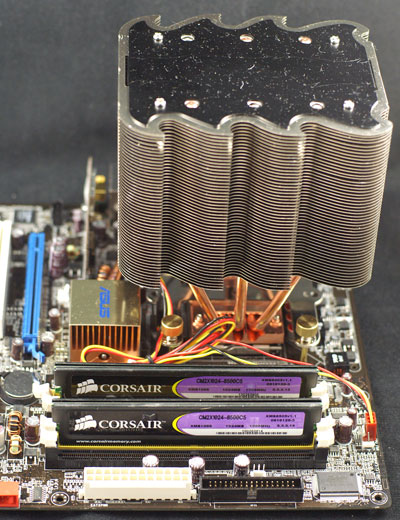
The goal was to reach the highest possible speed that was benchmark stable. Super Pi, 3DMarks, and several game benchmarks were run to test stability. The 2.93GHz chip reached 4.0GHz on air cooling in these overclocking tests. That represents a 36% overclock on air with what will likely be the least overclockable Core 2 processor - the top line X6800.
To provide some idea of overclocking abilities with other Core 2 Duo processors, we ran quick tests with E6700 (2.67GHz), and E6600 (2.4GHz). The test E6700 reached a stable 3.4GHz at default voltage and topped out at 3.9GHz with the Tuniq Cooler. The 2.4GHz E6600 turned out to be quite an overclocker in our tests. Even though it was hard-locked at a 9 multiplier it reached an amazing 4GHz in the overclocking tests. That represents a 67% overclock.
We had another Core 2 Extreme X6800 that we tried overclocking with a stock Intel HSF. The results were not as impressive as with the Tuniq cooler, with 3.4GHz being the most stable we could get it. We're going to be playing around with these processors more in the future to hopefully get a better overall characterization of what you can expect.
Curious about our overclocking successes, we asked Intel why Core 2 CPUs are able to overclock close to the same levels as NetBurst processors can, despite having less than half the pipeline length. Intel gave us the following explanation:
NetBurst microarchitecture is constrained by physical power / thermal limitations long before the constraint of pipeline stages comes into play. The microarchitecture itself would continue to scale upwards if not for the power constraints. (In fact, we have seen Presler overclocked to 6 GHz in liquid nitrogen environments. At that level, power delivery through the power supply & board itself begin to limit further scaling of the processor.)
Intel's explanation makes a great deal of sense, especially when you remember the original claims that NetBurst was supposed to be good for between 5GHz - 10GHz. NetBurst never got the chance to reach its true overclocking prime as Intel hit thermal density walls well before the 5GHz - 10GHz range and thus Intel's Core architecture was born. Intel's Core 2 processors once again give us an example of the good ol' days of Intel overclocking, where moving to a smaller manufacturing process meant we'd have some highly overclockable chips on our hands. With NetBurst dead and buried, the golden age of overclocking is back.
Enthusuasts have not seen overclocking like this since Socket 478 days, and in fact Core 2 may be even better. The 2.4GHz E6600, which outperformed the FX-62 in most benchmarks at stock speed costs $316, and overclocked to 4Ghz with excellent air cooling. With that kind of performance, value, and overclocking the E6600 will likely become the preferred chip for serious overclockers - particularly those that are looking for champagne performance on a smaller budget.
It is important, however, not to sell the advantages of the X6800 short. AnandTech never recommends the fastest chip you can buy as a good value choice, but X6800 does bring some advantages to the table. It is the only Conroe that is completely unlocked. This allows settings like 266(stock FSB)x15 for 4.0GHz, settings that keep other components in the system at stock speed. This can only be achieved with the X6800 - other Core 2 Duo chips are hard-locked - and for some that feature will justify buying an X6800 at $999. For the rest of us overclockers E6600 is shaping up to be the chip to buy for overclocking.
Final Words
Intel's Core 2 Extreme X6800 didn't lose a single benchmark in our comparison; not a single one. In many cases, the $183 Core 2 Duo E6300 actually outperformed Intel's previous champ: the Pentium Extreme Edition 965. In one day, Intel has made its entire Pentium D lineup of processors obsolete. Intel's Core 2 processors offer the sort of next-generation micro-architecture performance leap that we honestly haven't seen from Intel since the introduction of the P6.
Compared to AMD's Athlon 64 X2 the situation gets a lot more competitive, but AMD still doesn't stand a chance. The Core 2 Extreme X6800, Core 2 Duo E6700 and E6600 were pretty consistently in the top 3 or 4 spots in each benchmark, with the E6600 offering better performance than AMD's FX-62 flagship in the vast majority of benchmarks. Another way of looking at it is that Intel's Core 2 Duo E6600 is effectively a $316 FX-62, which doesn't sound bad at all.
We're still waiting to get our hands on the E6400 as it may end up being the best bang for your buck, but even the slower E6300 is quite competitive with AMD's X2 4200+ and X2 3800+. If AMD drops the price on those two parts even more than we're expecting, then it may be able to hold on to the lower end of the performance mainstream market as the E6300 is not nearly as fast as the E6600.
As impressed as we are with Intel's Core 2 processor lineup, we are still very concerned about availability and street pricing. To quote from our last Core 2 preview article:
While Intel's Core 2 Duo and Core 2 Extreme processors will be released at the beginning of Q3 of this year it will take some time for all of Intel's shipments to be Conroe based. The scary statistic is that by the end of this year, only 25% of Intel's Performance Mainstream desktop processor shipments will be based on Conroe. The remaining 75% will still be NetBurst based, meaning they will be Pentium 4, Pentium D and Pentium Extreme Edition.
...
For the Dells of the world, Conroe availability shouldn't be too much of an issue because companies like Dell get first dibs. For years of not going with AMD, all while demanding something more competitive from Intel, you better believe that Dell is going to soak up every last Conroe that it can.
The problem then becomes what happens after Dell and HP have eaten their lunch; unfortunately the concern is that aggressive pricing won't be enough to reduce retail demand for Conroe. What we're worried about happening is a very small supply of Conroes on the retail market in late Q3/early Q4, resulting in much higher street prices than what you see on page 2. In the worst case scenario for Intel, Conroe's limited retail availability could result in a price to performance ratio equal to or worse than AMD's Athlon 64 X2.
Despite pulling in the official launch date for Core 2 processor benchmarks, shipment dates for the CPUs haven't changed. According to Intel:
Intel Core 2 Extreme processor based systems and boxed product are expected to be available on the day of launch, 27 July. Intel Core 2 Duo processor based systems and boxed product [through places such as Newegg] are expected to be available from 7 August. Each OEM has their own product introduction / transition cycles based upon their target market segment and current product offerings. We expect some to offer product in August with more introductions extending through September. Check with the OEMs of your choice to get their specific message on system availability.
From what Intel is telling us, you shouldn't be able to so much as purchase Core 2 processors until after the first week in August, although you'll be able to get complete systems before then. At the same time, we're hearing that distributors already have some Core 2 parts in stock and will begin shipping very soon. While we tend to believe Intel's assessment of availability, we're hoping it's conservative.
If Intel's availability statements are true or even worse, overly optimistic, then don't expect to be upgrading to a Core 2 system anytime soon. However, if all goes well, although Vista may be delayed until 2007, Intel's Core 2 processors will give you a very good reason to upgrade this year.

